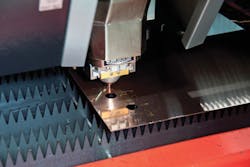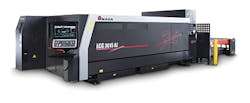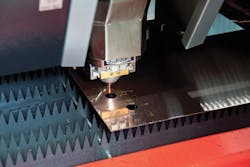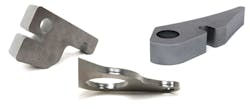Fiber laser cutting drives a power revolution
Fiber lasers boost production output at lower cost
JASON HILLENBRAND
For over 30 years, carbon-dioxide (CO2) lasers have reached what seems like a threshold of power and capability, with the majority of CO2 laser machines being purchased in the 4–5kW range (with occasional 6kW versions purchased). It took approximately 15 years before 3kW CO2 laser sales became common, and another five years or so before 4kW became the main power choice of end users. Higher-power CO2 lasers (6kW and higher) have been available for many years, going back into the 1990s. And while sales of high-power CO2 lasers increased slightly in the 2000s, they never approached the volume of sales in the 4–5kW range. There are good reasons for that—and when one looks at benefit vs. cost, it becomes a little clearer as to why.
First of all, there have been great improvements in CO2 laser technology, with the advent of beam choppers, electronically controlled shutters, polarization, beam collimation, better controls, and so on. And as these developments improved CO2 lasers, they became more user-friendly. The industry demand was not for the high-mix, low volume of today—we really did not see this strategy until the crash in 2000. But the industry was changing and efficiency in manufacturing was still improving. As CO2 lasers improved, so did their demand and sales. With that said, CO2 lasers still were relatively expensive, and required a lot of incoming power and maintenance.
The mid-1990s saw a stronger movement towards laser technology and by the time the market crashed in 2000, lasers were already mainstream, rivaling punching as the primary weapon of choice in the manufacturing sector. So, the strategy for manufacturing went into a streamlined overhaul overnight, as the term "high-mix, low-volume" became the new mantra for efficient manufacturing. This demanded just-in-time production and the laser was the tool because they reduce or eliminate setup when switching from job to job. It makes no difference if it is a 10-piece job in 16-gage steel or a 1000-piece job in 1/4in. steel—the beam of a laser is the ultimate tool.
The sweet spot of 4000–5000W of power was ideal for 99% of anything that had to be cut. So, why didn't 6000W or higher CO2 lasers dominate the market? There is not one definitive answer, but it certainly could be any combination of things. We know that these higher-wattage machines could clean-cut with nitrogen (N2) faster than lower-wattage 4 and 5kW lasers. The higher-power spot density allowed for faster vaporization of material, which in turn allowed for faster head movement and cutting process. The direct result would be faster overall production of parts cut with N2, and no secondary processes to remove oxidation for painting or welding operations downstream.
Oxidation is a common byproduct of using oxygen (O2) as an assist gas. To help give an idea of the benefit to a 6kW CO2 laser vs. a 4kW version in 1/4 in. mild steel with N2 as the assist gas, the 4kW will cut this material around 60–80 inches per minute (IPM). The 6kW version will be approximately 110–120 IPM. In addition to significantly faster speeds, the higher-power CO2 laser also increased capacity thickness, expanding a shop's capability to process thicker mild and stainless steels, as well as aluminum. So, it would seem like this technology would be a logical step in the evolutionary process to become more productive and efficient. However, that is where CO2 lasers seemed to have found the proverbial ceiling. Higher power in the CO2 laser world comes at a price and for every increase in wattage, there are also increases in the cost of operation, number of components, electrical consumption, and overall maintenance of the system. There is a distinct tradeoff for capital investment and increased cost of operation vs. productivity and increased capability. The justification is often a stretch, guiding the buyer back into that 4–5kW range once again.
The breakthrough
After 2000, lasers dominated the blanking market for fabricating, outselling punching on a regular basis—a title it still holds today. In 2005, fiber technology became a buzzword for laser cutting, and while there were areas of sales within the US market, most of the early sales were seen in the European manufacturing market. In fact, most of the primary laser original equipment manufacturers (OEMs) did not even have fiber laser technology in their lineup yet. From around 2005 to 2010, fiber sales were very small in volume in the US, with maximum available wattages around 2kW. It was at the 2010 EuroBLECH tradeshow in Germany when several of the larger OEMs unveiled their versions of the technology, and at the Fabtech 2011 tradeshow, it seemed like fiber lasers in the US had their coming-out party. Even so, fiber accounted for only about 5–10% of all laser sales for cutting applications in 2011. However, several manufacturers already had pushed the power envelope to 4kW right out of the gate. By Fabtech 2014 in Atlanta, fiber lasers were about the only kind of laser cutting machine at the show, with power levels of 2–12kW (FIGURE 1) on the floor! In this same timeframe, the percentage of fiber vs. CO2 laser sales has risen dramatically, with 2015 showing fiber lasers outselling CO2 lasers for the first time.
From 2005 to 2010, fiber laser sales remained modest. This could be for several reasons, but most likely it had to do with familiarity and a comfort level. In that timeframe, few of the larger OEMs offered this option, and end users were uncertain if this technology was here to stay or just a passing fancy. As more OEMs began to offer their machines and more machines began to get into the field, legitimacy came to the technology. Once this hurdle was overcome, the fiber laser revolution turned into a power revolution, with wattages increasing seemingly every 6 months or so.
The New Age
As fiber lasers grew to what they are today, the industry was learning the benefits and the reality this technology offered. When first introduced, one of the primary selling points was the low operating cost vs. CO2 lasers. The operating cost of a fiber laser is a fraction of CO2 lasers and even lower compared to alternative cutting methods, as a fiber laser requires no maintenance to the source. But more importantly, the simplicity of the design means increasing power does not mean significantly increasing consumables, electrical consumption, or maintenance. In fact, the limiting factor for increasing power revolves around the ability to scale diodes and modules while maintaining a high-quality beam. By doing this, the power is increased, allowing for faster and thicker processing. Today's 6kW fiber laser can process that same 1/4in. mild steel with N2, as we mentioned before, at 200 IPM (FIGURE 2). If you recall, the 6kW CO2 laser was in the 110–120 IPM range.
So, one can assume that the dramatic increase in power is driven by demand in the marketplace, and the fact that the marketplace is accepting this power revolution because there is not yet a significant downside. The justification of fiber laser productivity vs. cost is much easier to make than with the CO2 laser in these higher power ranges—along with this comes the increase in capacity. Fiber lasers are also a strong alternative to blanking methods such as plasma and water jet, as fiber lasers can effectively cut thick plate and the wavelength is now conducive to cutting unique materials such as copper (FIGURE 3). Today's fiber lasers have only a few optics in their cutting head plus one cutting nozzle, both of which are relatively inexpensive over the life of the machine. Operating costs on fiber lasers will generally range between $1–3 per hour, depending upon what is included in those costs and how they are calculated. This, combined with the overall capability of the new generation of fiber lasers, makes the fiber laser an attractive alternative to almost any current blanking process.
Considerations
Of course, there are caveats that must be addressed, and high-wattage fiber lasers are proving to offer their own manufacturing balancing acts. Some might consider these "good" issues, but they do require additional planning. A 6kW fiber laser is significantly faster than the 4 and 2kW fiber laser machines, as well as any CO2 laser alternative. Add plasma and water jet in the mix, and the productivity of this one machine will double or even triple throughput from the same or less floor space compared to previous operations. Some manufacturers have even reported that their machine is so fast that the Green Light On is actually lower than their slower predecessors, mainly because of the fact that these lasers are piling up downstream processes. This ability to overload production has forced manufacturers to rethink downstream processes like material handling and bending operations. A balanced shop flow can be easily altered by just one high-powered machine and can often mean that the next capital investment may need to be focused on the bending process, such as auto-tool-change press brakes and robotic technology. And what about material handling? These are serious considerations that may not have been considered before—but make no mistake, high-power fiber lasers will improve overall throughput.
In summary, high-power fiber lasers have evolved and quickly found their place in the fabricating industry for many reasons. They are as easy to operate as their lower-powered counterparts. Any additional capital investment can be offset by significantly higher production and lower operating costs than CO2 laser machines in that power range. The ability of fiber lasers to process thick plate (FIGURE 4) has also opened the door to alternative processes, such as plasma and water jet. The industry has lifted the veil of obscurity and shown fiber lasers to be a viable solution for today's blanking needs, such that it suddenly has become the blanking solution to address that ever-shrinking wiggle room between low-volume orders and profitable production output. High power, more production, less cost, more flexibility, and more profit—today's fiber laser offers all of this to manufacturers.
JASON HILLENBRAND([email protected]) is laser product manager for Amada America, Buena Park, CA; www.amada.com/america.




